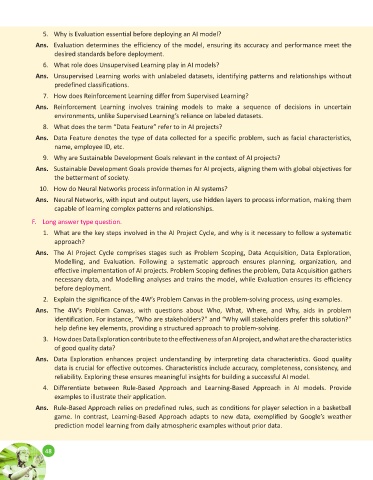Page 174 - Ai Book - 10
P. 174
5. Why is Evaluation essential before deploying an AI model?
Ans. Evaluation determines the efficiency of the model, ensuring its accuracy and performance meet the
desired standards before deployment.
6. What role does Unsupervised Learning play in AI models?
Ans. Unsupervised Learning works with unlabeled datasets, identifying patterns and relationships without
predefined classifications.
7. How does Reinforcement Learning differ from Supervised Learning?
Ans. Reinforcement Learning involves training models to make a sequence of decisions in uncertain
environments, unlike Supervised Learning’s reliance on labeled datasets.
8. What does the term “Data Feature” refer to in AI projects?
Ans. Data Feature denotes the type of data collected for a specific problem, such as facial characteristics,
name, employee ID, etc.
9. Why are Sustainable Development Goals relevant in the context of AI projects?
Ans. Sustainable Development Goals provide themes for AI projects, aligning them with global objectives for
the betterment of society.
10. How do Neural Networks process information in AI systems?
Ans. Neural Networks, with input and output layers, use hidden layers to process information, making them
capable of learning complex patterns and relationships.
F. Long answer type question.
1. What are the key steps involved in the AI Project Cycle, and why is it necessary to follow a systematic
approach?
Ans. The AI Project Cycle comprises stages such as Problem Scoping, Data Acquisition, Data Exploration,
Modelling, and Evaluation. Following a systematic approach ensures planning, organization, and
effective implementation of AI projects. Problem Scoping defines the problem, Data Acquisition gathers
necessary data, and Modelling analyses and trains the model, while Evaluation ensures its efficiency
before deployment.
2. Explain the significance of the 4W’s Problem Canvas in the problem-solving process, using examples.
Ans. The 4W’s Problem Canvas, with questions about Who, What, Where, and Why, aids in problem
identification. For instance, “Who are stakeholders?” and “Why will stakeholders prefer this solution?”
help define key elements, providing a structured approach to problem-solving.
3. How does Data Exploration contribute to the effectiveness of an AI project, and what are the characteristics
of good quality data?
Ans. Data Exploration enhances project understanding by interpreting data characteristics. Good quality
data is crucial for effective outcomes. Characteristics include accuracy, completeness, consistency, and
reliability. Exploring these ensures meaningful insights for building a successful AI model.
4. Differentiate between Rule-Based Approach and Learning-Based Approach in AI models. Provide
examples to illustrate their application.
Ans. Rule-Based Approach relies on predefined rules, such as conditions for player selection in a basketball
game. In contrast, Learning-Based Approach adapts to new data, exemplified by Google’s weather
prediction model learning from daily atmospheric examples without prior data.
48
48

